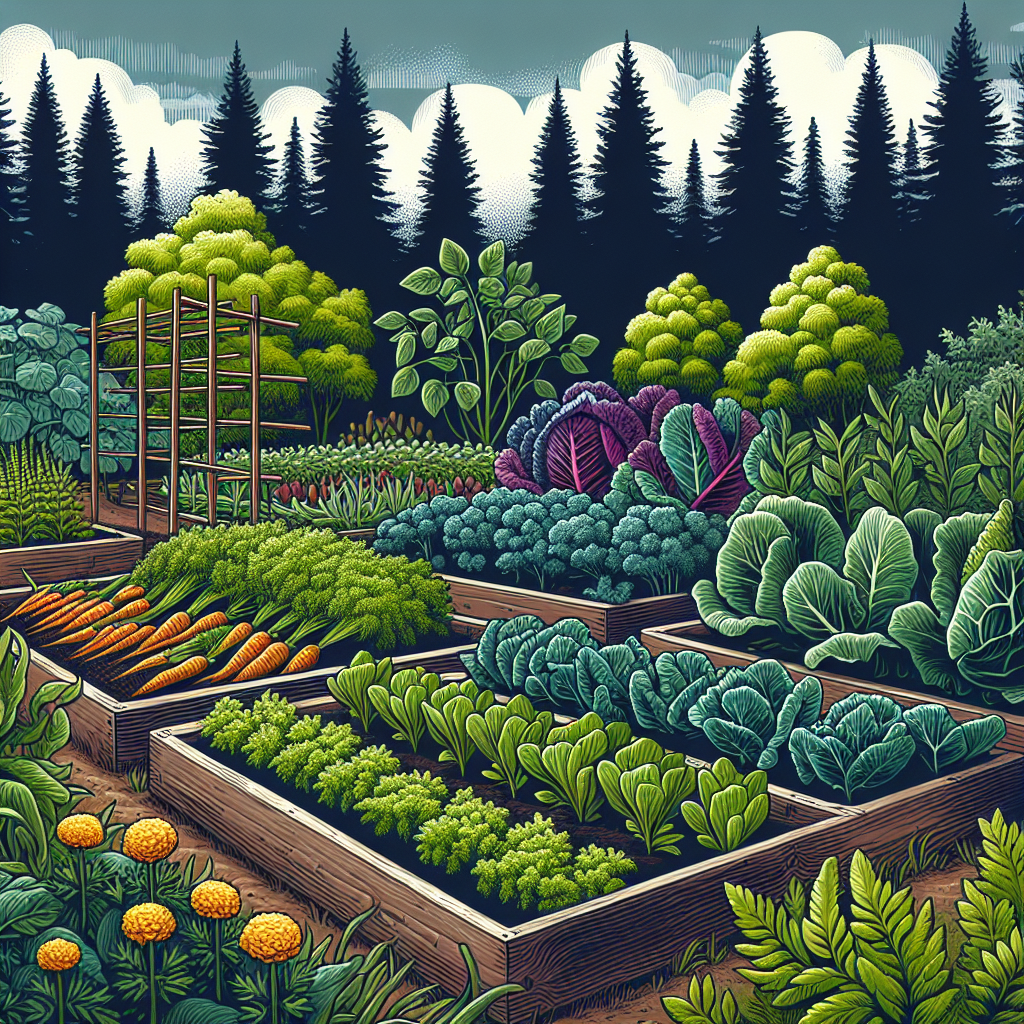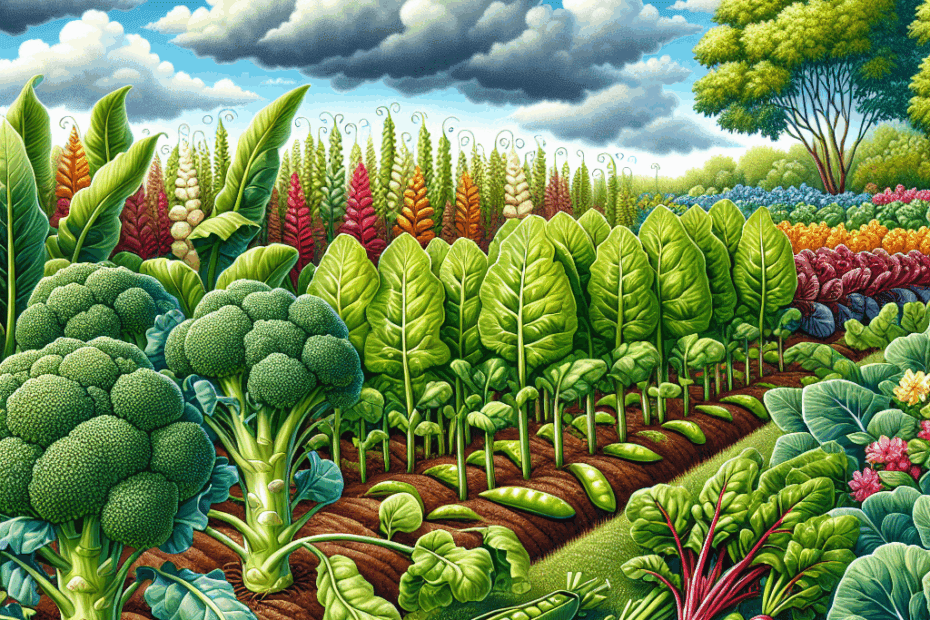Best Vegetables to Grow in the Northwest – Intro
The Pacific Northwest, with its mild climate and abundant rainfall, offers a unique environment for cultivating a diverse array of vegetables. Gardeners in this region can take advantage of the long growing season and fertile soil to produce a bountiful harvest. Some of the best vegetables to grow in the Northwest include cool-season crops like kale, spinach, and lettuce, which thrive in the cooler temperatures and can be planted in early spring or fall. Root vegetables such as carrots, beets, and radishes also perform well, benefiting from the region’s well-drained soils. Additionally, peas and beans are excellent choices, as they can handle the cooler nights and provide a rich source of nutrients. For those looking to extend their growing season, hardy varieties of broccoli and cabbage can withstand the cooler temperatures and continue to produce into the late fall. By selecting the right vegetables and timing their planting appropriately, gardeners in the Northwest can enjoy a productive and rewarding growing season.
Top 5 Hardy Vegetables for Northwest Gardens
The Pacific Northwest, with its unique climate characterized by mild, wet winters and cool, dry summers, presents both challenges and opportunities for gardeners. The region’s temperate conditions are ideal for cultivating a variety of hardy vegetables that thrive in cooler temperatures and can withstand the occasional bout of inclement weather. Understanding which vegetables are best suited for this environment can significantly enhance the success of a garden. Among the top contenders are kale, carrots, broccoli, peas, and beets, each offering distinct advantages and contributing to a diverse and productive garden.
Kale stands out as a quintessential vegetable for Northwest gardens due to its remarkable resilience and nutritional value. This leafy green thrives in cooler temperatures and can even withstand light frosts, which often enhance its flavor. Kale’s ability to grow throughout the fall and into the winter months makes it an excellent choice for gardeners seeking a continuous harvest. Moreover, its versatility in the kitchen, whether used in salads, soups, or smoothies, adds to its appeal.
Transitioning from leafy greens to root vegetables, carrots are another excellent option for Northwest gardens. Carrots prefer the loose, well-drained soils commonly found in the region and benefit from the cool growing conditions. These conditions help develop their sweetness, making them a favorite among gardeners and chefs alike. Carrots can be sown in early spring and harvested throughout the summer and fall, providing a steady supply of this nutritious vegetable. Additionally, their ability to be stored for extended periods makes them a practical choice for those looking to enjoy homegrown produce year-round.
Broccoli, a member of the brassica family, is well-suited to the Northwest’s climate. This vegetable thrives in cooler temperatures and can be planted in both spring and fall for multiple harvests. Broccoli’s robust nature allows it to withstand the region’s occasional temperature fluctuations, and its high nutritional content, including vitamins C and K, makes it a valuable addition to any garden. Furthermore, broccoli’s versatility in culinary applications, from steaming to roasting, ensures it remains a staple in many households.
Peas, with their sweet flavor and ease of growth, are another excellent choice for Northwest gardeners. These legumes prefer the cool, moist conditions typical of the region’s spring and early summer. Peas can be planted as soon as the soil can be worked in the spring, allowing for an early harvest. Their ability to fix nitrogen in the soil also benefits subsequent crops, enhancing soil fertility and promoting sustainable gardening practices. Whether enjoyed fresh from the vine or preserved for later use, peas are a delightful addition to any garden.
Finally, beets offer both culinary and aesthetic benefits to Northwest gardens. These root vegetables thrive in the region’s cool climate and can be planted in early spring or late summer for a fall harvest. Beets are known for their vibrant colors and earthy flavor, making them a favorite among chefs and home cooks. Additionally, both the roots and greens are edible, providing a versatile ingredient for a variety of dishes. Beets’ ability to store well through the winter months further enhances their appeal, ensuring a supply of homegrown produce long after the growing season has ended.
The Pacific Northwest’s unique climate provides an ideal environment for cultivating a variety of hardy vegetables. By selecting crops such as kale, carrots, broccoli, peas, and beets, gardeners can enjoy a bountiful and diverse harvest while taking advantage of the region’s natural conditions. These vegetables not only offer nutritional benefits but also contribute to sustainable gardening practices, making them an excellent choice for any Northwest garden.
Year-Round Vegetable Growing Tips for the Northwest

Growing vegetables year-round in the Northwest can be a rewarding endeavor, thanks to the region’s mild climate and fertile soil. However, to maximize success, it is essential to select the right vegetables and employ effective growing techniques. The Northwest’s climate, characterized by wet winters and dry summers, offers unique opportunities and challenges for gardeners. By understanding these conditions, one can make informed decisions about which vegetables to cultivate throughout the year.
To begin with, cool-season crops are particularly well-suited for the Northwest’s climate. Vegetables such as kale, spinach, and lettuce thrive in the cooler temperatures of spring and fall. These leafy greens are not only nutritious but also relatively easy to grow. They can be sown directly into the soil as soon as it is workable in early spring, and successive plantings can ensure a continuous harvest. Additionally, these crops can withstand light frosts, making them ideal for extending the growing season into late fall.
Transitioning to summer, the focus shifts to warm-season vegetables. Tomatoes, peppers, and cucumbers are popular choices for Northwest gardens during this time. These plants require more sunlight and warmer temperatures to flourish, so it is advisable to start them indoors in late winter or early spring. Once the danger of frost has passed, they can be transplanted outdoors. Utilizing raised beds or containers can help improve drainage and soil temperature, further enhancing growth. Moreover, mulching around these plants can conserve moisture and suppress weeds, which is particularly beneficial during the drier summer months.
As summer wanes, attention returns to cool-season crops. Root vegetables such as carrots, beets, and radishes are excellent choices for late summer planting. These crops can be sown directly into the ground and will mature as the temperatures begin to drop. The cooler weather enhances their flavor, and they can often be left in the ground until needed, providing fresh produce well into winter. Furthermore, employing row covers or cold frames can protect these vegetables from early frosts, extending their growing period.
In addition to selecting the appropriate vegetables, employing season extension techniques can significantly enhance year-round gardening success. Cold frames, hoop houses, and greenhouses are invaluable tools for Northwest gardeners. These structures create microclimates that protect plants from harsh weather conditions, allowing for earlier planting in spring and prolonged harvests in fall and winter. By utilizing these methods, gardeners can enjoy fresh produce even during the coldest months.
Moreover, soil health is a critical factor in successful year-round gardening. The Northwest’s abundant rainfall can leach nutrients from the soil, so regular soil testing and amendment are essential. Incorporating organic matter such as compost or well-rotted manure can improve soil structure and fertility. Additionally, practicing crop rotation and cover cropping can help maintain soil health and reduce pest and disease pressure.
Growing vegetables year-round in the Northwest requires careful planning and consideration of the region’s unique climate. By selecting appropriate crops for each season and employing techniques to extend the growing period, gardeners can enjoy a bountiful harvest throughout the year. With attention to soil health and the use of protective structures, the challenges of Northwest gardening can be effectively managed, resulting in a productive and rewarding gardening experience.
Best Cool-Season Vegetables for Northwest Climates
The Pacific Northwest, with its unique climate characterized by mild, wet winters and cool, dry summers, presents an ideal environment for cultivating a variety of cool-season vegetables. Gardeners in this region can take advantage of the extended growing season to produce a bountiful harvest of nutritious and flavorful crops. Understanding which vegetables thrive in these conditions is essential for maximizing yield and ensuring a successful gardening experience.
To begin with, leafy greens such as kale and spinach are excellent choices for Northwest gardens. These hardy vegetables are well-suited to the cooler temperatures and can be planted as early as late winter. Kale, in particular, is known for its resilience to frost, which not only extends its growing season but also enhances its flavor.
Spinach, on the other hand, prefers the cooler temperatures of spring and fall, making it an ideal crop for successive planting. By staggering the planting times, gardeners can enjoy a continuous supply of fresh greens throughout the year.
In addition to leafy greens, root vegetables such as carrots and beets are also well-adapted to the Northwest climate. Carrots, with their preference for loose, well-drained soil, thrive in the region’s sandy loam. They can be sown directly into the ground as soon as the soil is workable in early spring. Beets, similarly, are cold-tolerant and can be planted in early spring or late summer for a fall harvest. Both of these root vegetables benefit from the cool temperatures, which help to develop their sweet flavors.
Moreover, the Northwest’s climate is conducive to growing members of the Brassica family, including broccoli and Brussels sprouts. These vegetables are known for their ability to withstand cooler temperatures and even light frosts. Broccoli, with its preference for cooler weather, can be planted in early spring or late summer.
It is important to note that consistent moisture is crucial for preventing the heads from becoming bitter. Brussels sprouts, on the other hand, require a longer growing season and are best planted in late spring for a fall harvest. The cool autumn temperatures enhance their flavor, making them a delightful addition to any meal.
Furthermore, peas are another excellent choice for Northwest gardeners. These legumes thrive in the cool, moist conditions of spring and fall. They can be planted as soon as the soil can be worked in early spring, and again in late summer for a fall crop. Peas not only provide a delicious and nutritious harvest but also enrich the soil with nitrogen, benefiting subsequent plantings.
Lastly, alliums such as onions and garlic are well-suited to the Northwest’s climate. Onions can be planted in early spring for a summer harvest, while garlic is typically planted in the fall and harvested the following summer. Both of these crops require well-drained soil and benefit from the region’s cool, moist conditions.
Best Vegetables to Grow in the Northwest – Wrap Up
The Northwest region, characterized by its mild, wet winters and warm, dry summers, is ideal for growing a variety of vegetables. Cool-season crops such as kale, spinach, and lettuce thrive in the early spring and fall, taking advantage of the cooler temperatures and ample rainfall. Root vegetables like carrots, beets, and radishes also perform well, benefiting from the region’s well-drained soils.
During the warmer months, heat-tolerant vegetables such as tomatoes, peppers, and zucchini can be successfully cultivated, provided they receive adequate sunlight and water. Additionally, peas and beans are excellent choices due to their adaptability to the Northwest’s climate. Overall, the region’s diverse growing conditions allow for a wide range of vegetables to be cultivated successfully, making it a gardener’s paradise.
